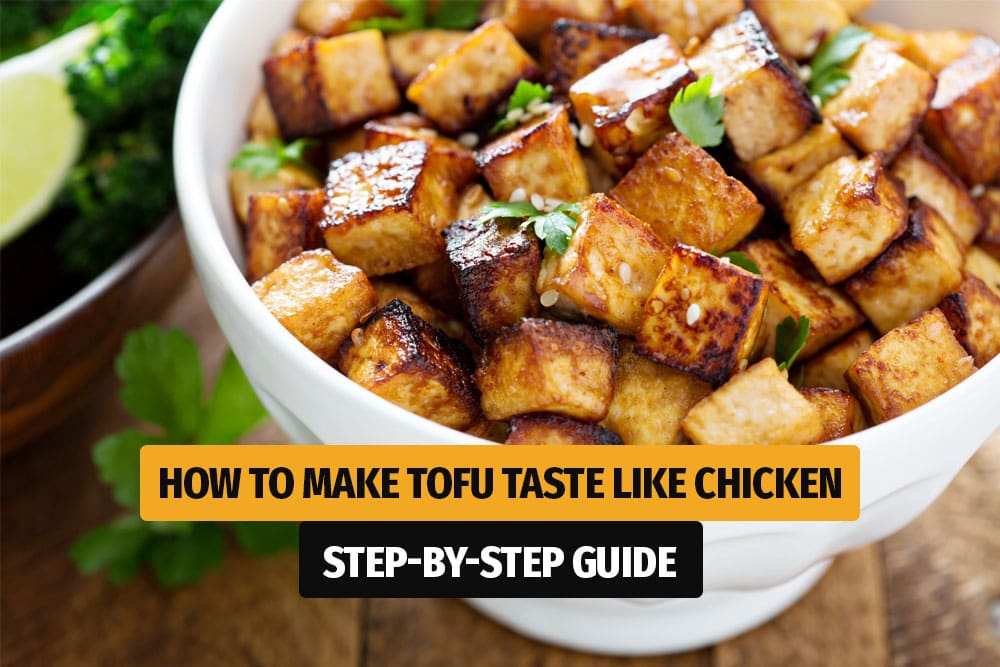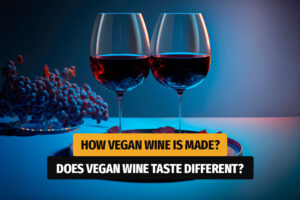
Using plant-based components, vegan meat replacements are a well-liked and mostly pretty tasty method to enjoy similar, meaty flavors and textures.
But there is a major difference between consuming meat replacements that are heavily processed and those that are derived from whole-food products. Here are some examples of the foods that vegans substitute for meat, whether for texture, taste, or additional nutrients.
Let’s get busy and see what do vegans eat to replace meat with these 10 tasty meat alternatives.
10 Vegan Foods to Replace Meat
1. Tempeh
Tempeh is a traditional soy food prepared from fermented soy. Soybeans are cultured and made into “cakes”. Similar to how cheese is made, the process of making tempeh makes use of unique bacterial cultures to break down the protein in the soybeans and make them more easily digestible by people.
Additionally, it can improve digestive health because it is a fermented meal. If you’re on a gluten-free diet, take care to carefully check labels because barley is frequently added to tempeh. Compared to tofu, tempeh has a stronger taste and a harder texture. It goes well with sauces made of peanuts and is simple to add to Thai salads or stir-fries.
2. Tofu
For decades, vegetarian diets have relied on tofu, which has also long been a mainstay of Asian cuisine. Even though it doesn’t have much taste on its own, it absorbs the flavors of the other components in a meal.
Soaked soybeans are blended into a smooth puree with water to create tofu. The stiff, fibrous components are then separated from the liquid portion of the puree using filtering. The liquid is then heated to just below the boiling point and allowed to curdle, which causes the liquid to solidify.

You might find this interesting:
How to make tofu taste like chicken?
The residual solid material, also known as okara or soya, is then dried and utilized as mince, chunks, or cutlets while the tofu is pressed into slabs.
The nutritional profile of tofu can be altered during production by adding ingredients like calcium sulfate or magnesium chloride. Some varieties of tofu are also enriched with calcium, vitamin B12, and iron.
Choose an organic product if you’re worried about GMOs because the majority of soy produced in the US is genetically modified, unlike the soy in EU, where soy for human consumption is non-GMO.

3. Texturized Vegetable Protein (TVP)
A highly processed vegan meat alternative called TVP was created in the 60s by agribusiness giant Archer Daniels Midland. It is created by taking soy flour, a waste product of soy oil manufacturing, and utilizing solvents to remove the fat. As a result, the product is high in protein and low in fat.
Soy flour can be extruded into a variety of forms, including chunks and nuggets. You may get TVP in dehydrated form. However, processed, and frozen vegan foods tend to include it more frequently.
Since the majority of soy grown in the US is genetically modified, TVP is derived from traditional soy and probably contains GMOs. While TVP lacks taste on its own, it may give recipes like vegan chili sin carne a meaty mouthfeel.

4. Mushrooms
If you want a natural, whole-food alternative to meat, mushrooms are an excellent choice. They naturally have a delicious, meaty flavor that is umami rich. You may slice portobello mushroom caps and use them in stir-fries or tacos, or you can grill or broil them in place of burgers.
Mushrooms are a healthy food option for those attempting to lose weight since they are low in calories and high in fiber. They don’t have a lot of protein, though. Mushrooms can be added to pastas, stir-fries, and salads, or you can make a vegan portobello burger.
5. Seitan
Seitan is a protein found in wheat. It is a popular meat replacement that has been a mainstay in Asian cuisine for millennia since it is simple to season, cook, and has a consistency comparable to meat.
It is created by thoroughly washing wheat flour dough in water until just the wheat gluten remains after all the starch particles have been eliminated. The uncooked dough is boiled, baked, or steamed to give it a meaty texture.
Numerous products, such as cold cuts, sausages, and cutlets, include seitan. Seitan powder, which may be used to make vegan sausages or cold cuts at home, is readily and affordably accessible in many nations.
Although it takes time, vital wheat gluten may be manufactured at home from wheat flour. Seitan is not suited for people with celiac disease or those on gluten-free diets because it is essentially wheat gluten.

6. Oat Flakes
Oat flakes may be used to make excellent cutlets. These are made of deep-fried oat dough, vegetable broth, a little lard, chopped carrots or courgettis.
Any supermarket or discount store will sell oat flakes at a reasonable price, making them an excellent source of zinc and iron. Oat flakes offer a consistent stream of complex carbohydrates that can curb appetite and aid in weight reduction.
Oats are a protein source that is becoming more and more popular, and they can even be found as “pulled oats,” which are a replacement for pulled pork.
7. Jackfruit
Despite being a long-standing component of Southeast Asian cuisines, jackfruit has only lately gained popularity as a meat replacement in the US. It is a large tropical fruit with flesh that is reportedly comparable to pineapple in flavor and subtlety.
Jackfruit has a chewy texture and is frequently used as a replacement for pulled pork in BBQ dishes. You may get it canned or uncooked. Read labels carefully for additional sugar because some canned jackfruit is packed in syrup.
If you’re searching for a plant-based protein source, jackfruit might not be the ideal option because it’s low in protein and heavy in carbohydrates. However, it serves as a convincing meat replacement when combined with other high-protein meals.
8. Lupin Protein
Lupin is a kind of legume, high in protein, like soy beans. The production of lupin is particularly sustainable and simple in Europe, which has a great environment for it. It is thought to be one of the meat replacements of the future.
Cutlets, doner kebabs, and sausages are examples of products that include lupin protein. These may be purchased online, in most supermarkets that provide vegan food, and at most organic food stores.
9. Beans and Legumes
Cheap sources of plant-based protein that make robust and full meat replacements include beans and legumes. They are also unprocessed, whole-food.
Beans come in a wide variety, including chickpeas, black beans, lentils, and others. Because each bean has a somewhat different flavor, they complement many different types of food. For instance, black beans and pinto beans go well with Mexican dishes, but chickpeas and cannellini beans go well with Mediterranean cuisine.
Beans are a fantastic vegan source of iron and are high in fiber. they may be used in a variety of dishes, including burgers, stews, and soups. If you want a high-protein meal, opt for a lentil-based vegan sloppy joe.
Since we mentioned lentil, you might want to try our vegan lentil loaf recipe.

10. Green Spelt
Spelt is a wheat species and one of the earliest cultivated grains. The term “green spelt” refers to spelt grain that has not fully ripened. To extend its shelf life after harvesting, it is dried and then roasted.
The spelt gains a very strong flavor and is made easily digestible through this treatment. B vitamins are particularly abundant in green spelt, which also contains large amounts of magnesium and phosphorus.
Bruised grain and semolina prepared from green spelt are excellent bases for vegan patties, cutlets, and meat-free balls. Green spelt can be found in supermarkets and organic health food stores as partially cooked cutlets, smashed grain, or semolina.
Why Do Vegans Make Fake Meat?
Vegans make fake meat because it’s convenient, it tastes good, no animal has to die or suffer for this type of food, and it takes fewer natural resources (water e.g.) to produce plant-based foods than meat.
If you want to dig deeper why do vegans make fake meat, I suggest you continue reading. Let’s dig further into each factor.
Taste
It goes without saying that not all vegans are the same. Some vegans may readily admit that they like the tastes and textures of meat products, but they believe that killing an animal for human use is needless and immoral.
When given further consideration, this idea is not as unexpected. When a person has consumed meat products their whole life, their taste buds have been trained to appreciate these flavors and textures through the senses, cells, and neurochemical activation of the physical body.
Many individuals don’t notice a difference between the flavor or texture of meat made from plants and meat made from animals. To put it simply, these foods taste fantastic. This is possible because producers can now produce products that closely resemble the flavor and feel of genuine meat.
In the end, it is not meat that gives taste to the food. Spices are the ones that take care of the taste.

You might find this interesting:
How do you make vegan food taste better?
Convenience
Convenience is a major consideration for many individuals when making dietary decisions. This is particularly true for busy families that require quick and simple meals to prepare.
Fake meats have grown in popularity alongside animal meat products as more and more individuals explore practical vegan alternatives. Frequently pre-cooked, these items are simple to reheat or include in a variety of meals.
They are a healthy alternative for those on the road because they are frequently high in protein and other nutrients.
Ethics
An important aspect of veganism is the ethical part, meaning do your best to do as little harm to others as possible. By choosing fake meat, you are not harming any animals, so it is a win-win situation for you as for the animals – you get tasty food and animals get to live.
Natural Resources
When compared to the average American diet, a vegan’s water consumption is drastically reduced. On average, a vegan consumes nearly 600 gallons per day less water than someone who eats the typical American diet rich in meat.
How Do Vegans Make Meat?
Commercial vegan meat can contain a high percentage of processed components. One of the most well-known vegan meats, for instance, is made using pea protein, canola oil, coconut oil, rice protein, and potato starch.
These products are healthier for the environment but may not be healthier for you because they include protein and fat, much like meat. This is particularly true when you take into account the nutrients that can be obtained by preparing your own vegan meats from scratch using whole-food ingredients.

You might find this interesting:
How is Vegan Food Processed?
Meat replacements derived from entire foods and plants may be used to create delicious recipes. In dishes such as vegan cassoulet, vegan sandwiches, and vegan chorizo.
Bacon, pulled pork, ground beef, and chicken are substituted with various meat substitutes. Some of these options are straightforward. For instance, Tso’s recipe only substitutes cauliflower for the chicken. But there is vegan chorizo, which is made with a combination of kidney beans, walnuts, and sun-dried tomatoes.
Here is a video of how vegans make meat. Well, in this case it is not a vegan making it but nevertheless, he does a fantastic job making vegan pastrami from homemade seitan.
Is Vegan Meat Healthy?
When included in a balanced diet and consumed in moderation, it is frequently thought to be healthier. Vegan meat is high in protein, has less saturated fat, and is lower in cholesterol when compared to conventional meat.
Products made from plant-based “ground beef” often include significant amounts of iron, fiber, and folate. Additionally, compared to ground beef, the majority of the items were found to have much lower levels of saturated fat.
Still wondering is vegan meat healthy? No, if it is highly processed it is not healthy, but it is still healthier than meat which is high in saturated fat and made from animals which were fed mostly GMO soy and have often been injected with antibiotics.
The healthiest meat replacement option is whole-food like mushrooms, jackfruit, beans and similar.

You might find this interesting:
Are Vegan Hot Dogs Healthy?
Where Can I Get Vegan Meat?
Vegan meats are widely available. A wide variety of outstanding vegan meat products are available at almost any store. You can find them in freezers in form of vegan “fish-sticks”, “chicken nuggets” or in the fridge in form of burgers or minced “meat”.
You can find vegan meat in almost any country today, even in those that are famous for their heavy meat consumption like Bosnia or Serbia.
Germany is well known for its extremely wide choice of vegan meats. In some German cities you can even find vegan butcheries with just as many vegan meats as a traditional meat butchery.
Do Vegans Get Sick if They Eat Meat?
Not necessary. It can happen if some vegans are allergic to certain components of meat, resulting in symptoms such as migraines, bloating or gassiness, indigestion, or irritability.
Food sensitivities are a result of the enormous variety in people’s bodies and digestive systems, which is why they are so ambiguous and poorly understood.
Can Vegans Eat Meat That Died Naturally?
A vegan wouldn’t consume an animal whether it was killed (which is considered unethical) or died naturally. Being vegan is defined as exclusively ingesting items made from plants.
Even if you have eaten animals in the past, it might be challenging to view them as food when you are not used to doing so.
Let me put it this way – would you eat a human if he died a natural death? I don’t think so.
Can Vegans Eat Lab-grown Meat?
Since lab-grown meat contains cells from actual, living animals, it is not suitable for vegans. Lab-grown meat with animal origin isn’t something vegans would consider eating.
These types of meat are something that might appeal only to omnivorous customers.
Can Vegans Eat Imitation Crab Meat?
No, imitation crab meat is highly processed fish meat which makes it off-limits for vegans. It is a surimi-based product prepared by combining white-fleshed fish with other additives.
White-fleshed fish and other fish organs are crushed into a paste to make surimi. Manufacturers mold the paste to resemble crab meat by adding artificial flavoring, starch, salt, and MSG, as well as other substances.
Imitation crab is not vegan, but it is considered pescatarian. Due to its low cost, it frequently replaces crab in recipes.
Conclusion
There are now a huge number of natural and processed vegan meats available. Having so many meat alternatives available is definitely a good thing for the animals and for the environment. But often these meat substitutes or fake meats as we like to call them are highly processed and don’t have any valuable nutrients.
Nutritional profiles of meat alternatives range widely, so pick them depending on your individual dietary and nutritional requirements. Finding vegan meat replacements that meet your needs should be simple with so many options to select from.
Always go for the unprocessed whole-foods if possible and chose highly processed meat alternatives only when you have no other option.








